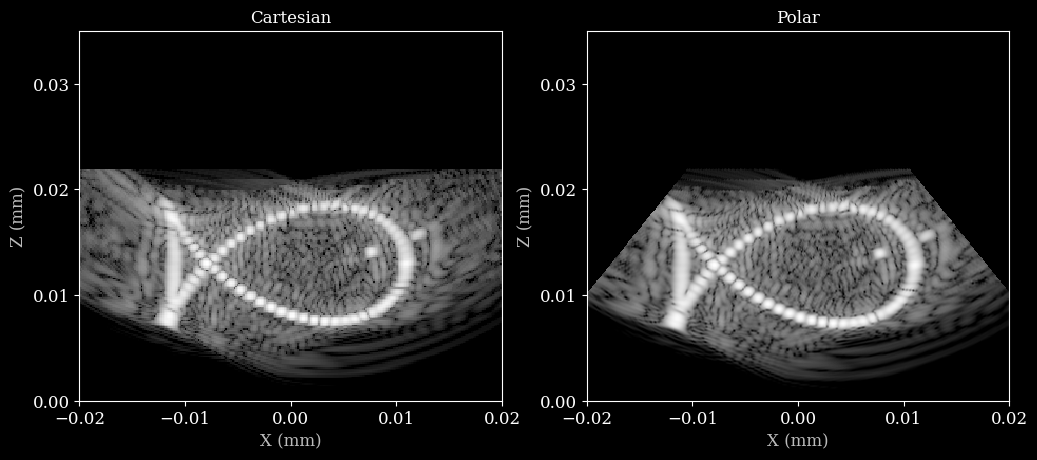Beamforming with a cartesian grid and a polar grid¶
In this notebook, we will demonstrate how you can do beamforming with zea using a cartesian grid and a polar grid. We will use the ScanConvert to convert the polar data to cartesian data.
[1]:
%%capture
%pip install zea
[2]:
import os
os.environ["KERAS_BACKEND"] = "jax"
os.environ["ZEA_DISABLE_CACHE"] = "1"
os.environ["TF_CPP_MIN_LOG_LEVEL"] = "3"
[3]:
import matplotlib.pyplot as plt
import numpy as np
import zea
from zea import ops
from zea.beamform.delays import compute_t0_delays_focused
from zea.beamform.phantoms import fish
from zea.probes import Probe
from zea.scan import Scan
from zea.visualize import pad_or_crop_extent, set_mpl_style
zea.init_device(verbose=False)
set_mpl_style()
zea: Using backend 'jax'
WARNING: All log messages before absl::InitializeLog() is called are written to STDERR
E0000 00:00:1752739728.747031 674733 cuda_dnn.cc:8579] Unable to register cuDNN factory: Attempting to register factory for plugin cuDNN when one has already been registered
E0000 00:00:1752739728.752641 674733 cuda_blas.cc:1407] Unable to register cuBLAS factory: Attempting to register factory for plugin cuBLAS when one has already been registered
W0000 00:00:1752739728.767638 674733 computation_placer.cc:177] computation placer already registered. Please check linkage and avoid linking the same target more than once.
W0000 00:00:1752739728.767654 674733 computation_placer.cc:177] computation placer already registered. Please check linkage and avoid linking the same target more than once.
W0000 00:00:1752739728.767657 674733 computation_placer.cc:177] computation placer already registered. Please check linkage and avoid linking the same target more than once.
W0000 00:00:1752739728.767658 674733 computation_placer.cc:177] computation placer already registered. Please check linkage and avoid linking the same target more than once.
Define zea.Probe and zea.Scan¶
Let’s initialize a linear ultrasound probe.
[4]:
n_el = 128
aperture = 30e-3
probe_geometry = np.stack(
[
np.linspace(-aperture / 2, aperture / 2, n_el),
np.zeros(n_el),
np.zeros(n_el),
],
axis=1,
)
probe = Probe(
probe_geometry=probe_geometry,
center_frequency=2.5e6,
sampling_frequency=10e6,
)
We will use a focused scan for this example.
[5]:
sound_speed = 1540.0
n_tx = 8
tx_apodizations = np.ones((n_tx, probe.n_el)) * np.hanning(probe.n_el)[None]
angles = np.linspace(30, -30, n_tx) * np.pi / 180
focus_distances = np.ones(n_tx) * 15e-3
t0_delays = compute_t0_delays_focused(
origins=np.zeros((n_tx, 3)),
focus_distances=focus_distances,
probe_geometry=probe.probe_geometry,
polar_angles=angles,
sound_speed=sound_speed,
)
scan = Scan(
n_el=n_el,
center_frequency=probe.center_frequency,
sampling_frequency=probe.sampling_frequency,
probe_geometry=probe.probe_geometry,
t0_delays=t0_delays,
tx_apodizations=tx_apodizations,
focus_distances=focus_distances,
polar_angles=angles,
initial_times=np.ones(n_tx) * 1e-6,
n_ax=1024,
lens_sound_speed=1000,
lens_thickness=1e-3,
sound_speed=sound_speed,
xlims=(-20e-3, 20e-3),
zlims=(0, 35e-3),
n_tx=n_tx,
n_ch=1,
)
Finally we initialize a scatterer phantom.
[6]:
# Initialize the fish phantom
scat_positions = fish()
n_scat = scat_positions.shape[0]
simulation_parameters = dict(
scatterer_positions=scat_positions.astype(np.float32),
scatterer_magnitudes=np.ones(n_scat, dtype=np.float32),
)
Initialize the pipeline¶
We initialize the default beamforming pipeline and prepend the simulator as the first operation. Finally, we normalize the beamformed data to [0, 255] range for visualization purposes.
[7]:
pipeline = ops.Pipeline.from_default()
pipeline.prepend(ops.Simulate())
pipeline.append(ops.Normalize(input_range=ops.DEFAULT_DYNAMIC_RANGE, output_range=(0, 255)))
Beamforming with a cartesian grid¶
[8]:
# Prepare parameters for the pipeline
scan.grid_type = "cartesian" # cartesian grid is the default
parameters = pipeline.prepare_parameters(probe, scan)
# Run the pipeline
image_cart = pipeline(**parameters, **simulation_parameters)["data"][0]
# Define the extent for the cartesian grid
extent_cart = [*scan.xlims, *scan.zlims]
zea: Caching is globally disabled for compute_pfield.
zea: Computing pressure field for all transmits
8/8 ━━━━━━━━━━━━━━━━━━━━ 8s 248ms/transmits
Beamforming with a polar grid¶
We add the scan convert operation to the pipeline because we will now use a polar grid.
[9]:
# Append ScanConvert to the pipeline
pipeline_sc = pipeline.copy()
pipeline_sc.append(ops.ScanConvert(order=3))
pipeline_sc.append(ops.Clip(0, 255))
# Prepare parameters for the pipeline
scan.grid_type = "polar" # update grid type to polar
parameters = pipeline_sc.prepare_parameters(probe, scan)
image_polar = pipeline_sc(**parameters, **simulation_parameters)["data"][0]
# Define the extent for the polar grid
radius = scan.zlims[1]
xlims = (
radius * np.cos(-np.pi / 2 + scan.theta_range[0]),
radius * np.cos(-np.pi / 2 + scan.theta_range[1]),
)
extent_polar = [*xlims, *scan.zlims]
zea: WARNING GPU support for order > 1 is not available. Disabling jit for ScanConvert.
zea: Caching is globally disabled for compute_pfield.
zea: Computing pressure field for all transmits
8/8 ━━━━━━━━━━━━━━━━━━━━ 0s 30ms/transmits
Visualize the beamformed data¶
Let’s put the images side by side to compare the beamformed data on a cartesian grid and a polar grid.
[10]:
# Make sure the polar image has the same extent as the cartesian image
image_polar_corrected = pad_or_crop_extent(image_polar, extent_polar, extent_cart)
fig, axs = plt.subplots(1, 2, figsize=(12, 6))
axs[0].imshow(image_cart, cmap="gray", extent=extent_cart, vmin=0, vmax=255)
axs[0].set_xlabel("X (mm)")
axs[0].set_ylabel("Z (mm)")
axs[0].set_title("Cartesian")
axs[0].locator_params(nbins=4)
axs[1].imshow(image_polar_corrected, cmap="gray", extent=extent_cart, vmin=0, vmax=255)
axs[1].set_title("Polar")
axs[1].set_xlabel("X (mm)")
axs[1].set_ylabel("Z (mm)")
axs[1].locator_params(nbins=4)

